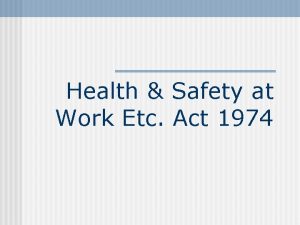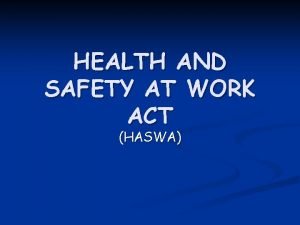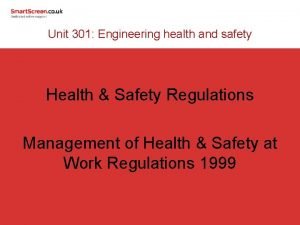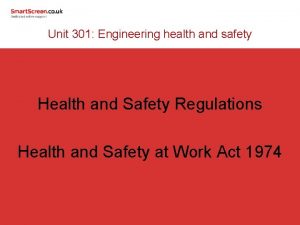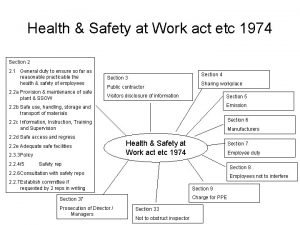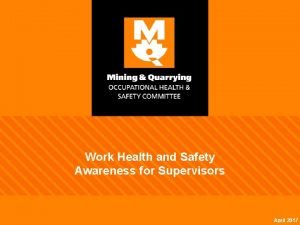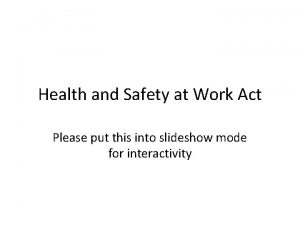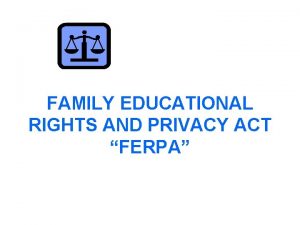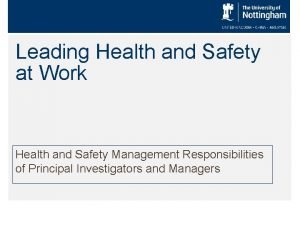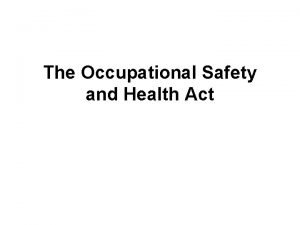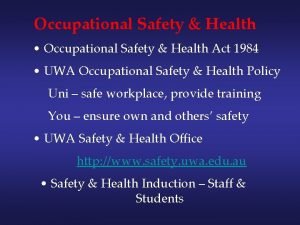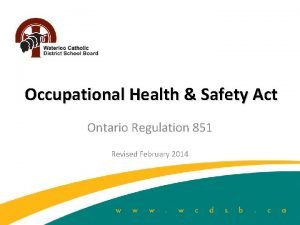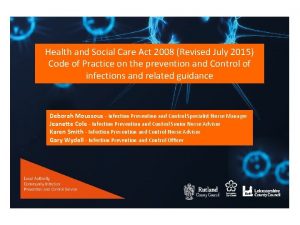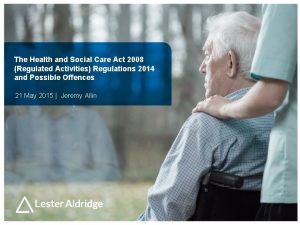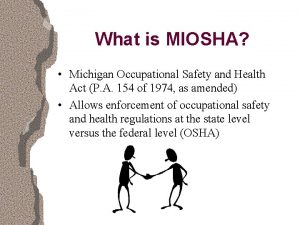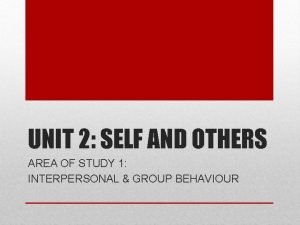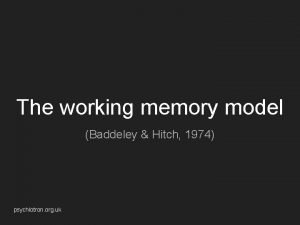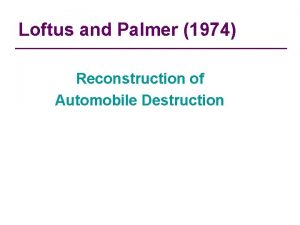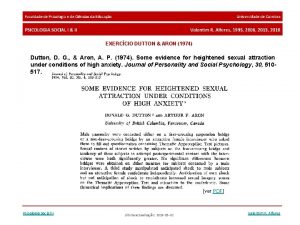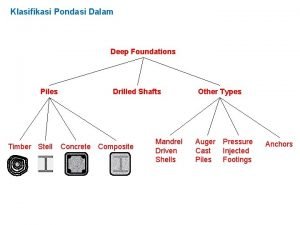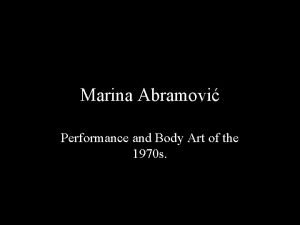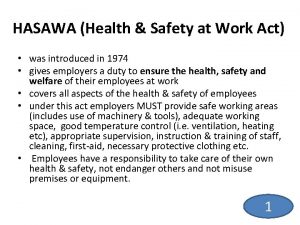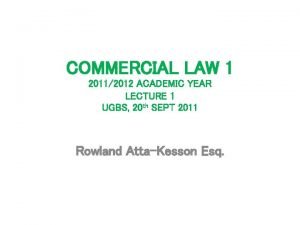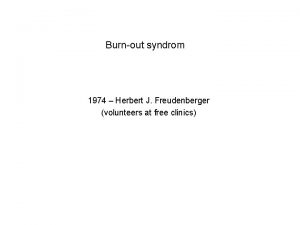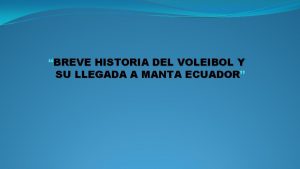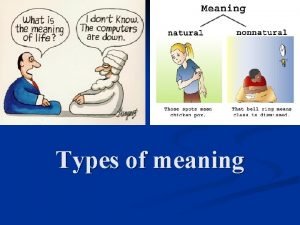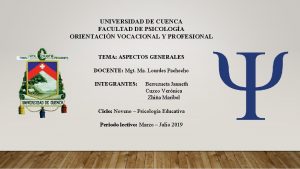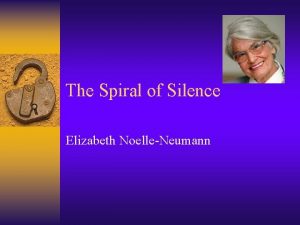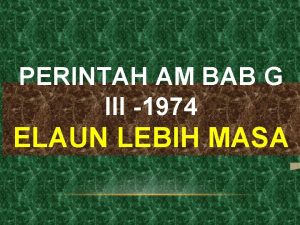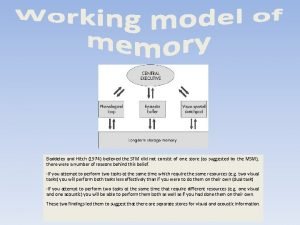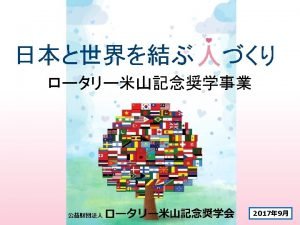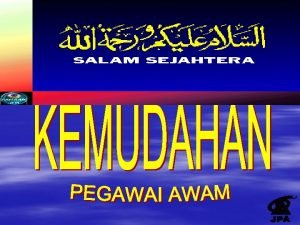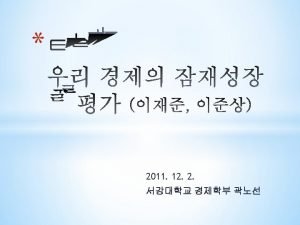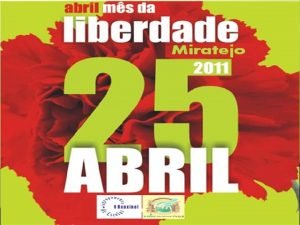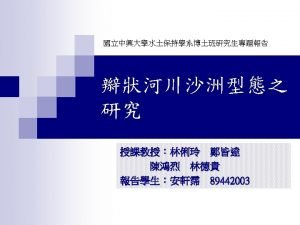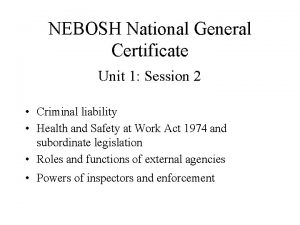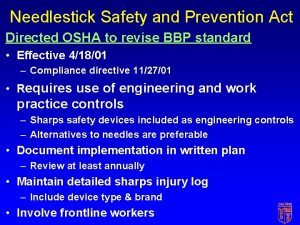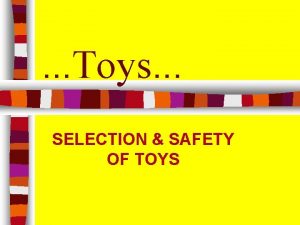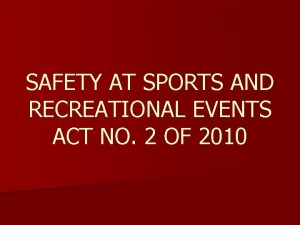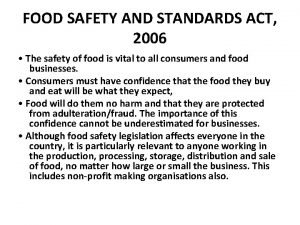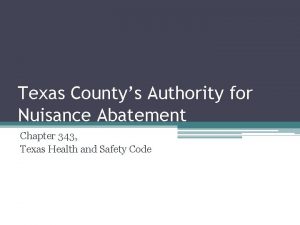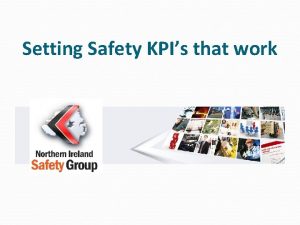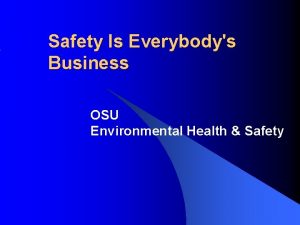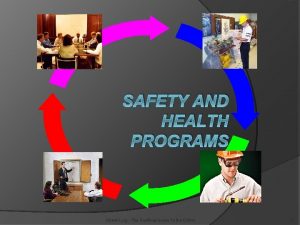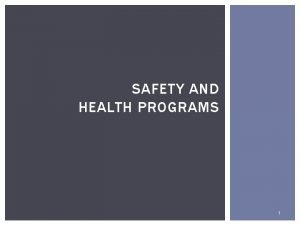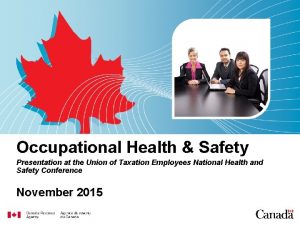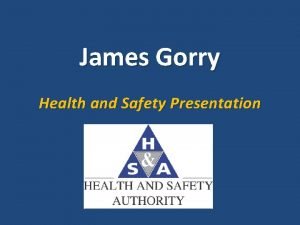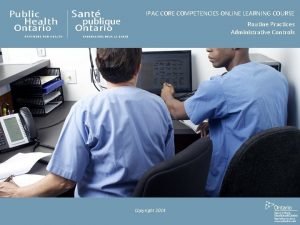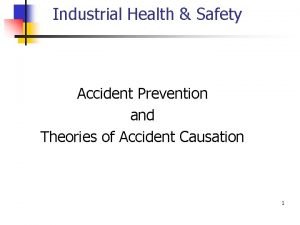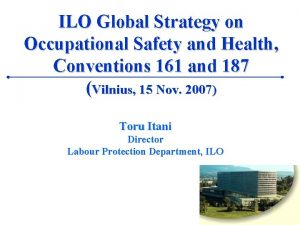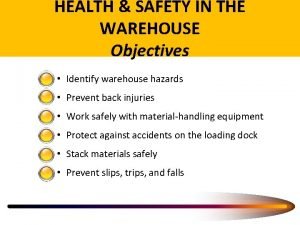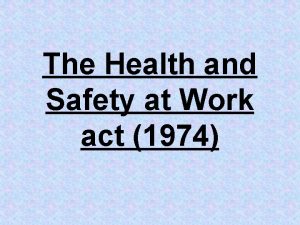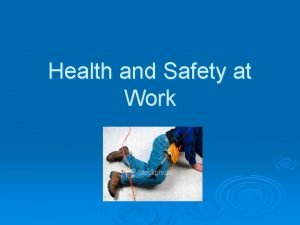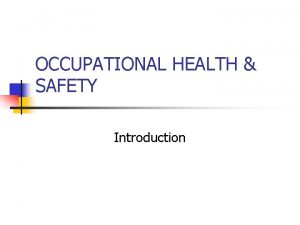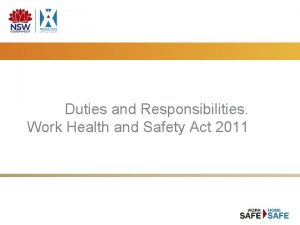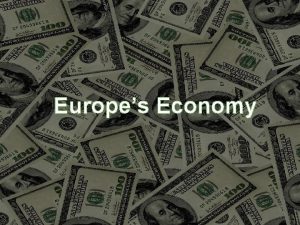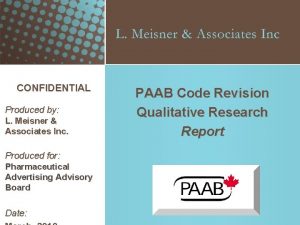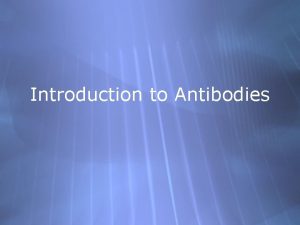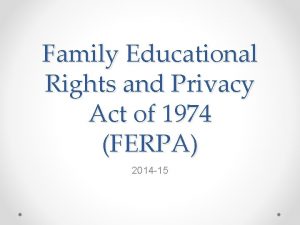HEALTH AND SAFETY AT WORK ACT 1974 Produced


































































- Slides: 66

HEALTH AND SAFETY AT WORK ACT 1974 Produced as part of the Partnership Development Schools (PDS) Strategy Phase 3 2008 -09 (Lead PDS: The Park Community School. Contact Chris Ley (cley@parkcommunity. devon. sch. uk)

DUTIES OF SCHOOLS • Produce a health and safety policy • Appoint a health and safety officer (this may be head) • Provide facilities for union health and safety representatives • Assess risks identified and reported, and act accordingly

SCHOOL HEALTH AND SAFETY POLICY • general law and aims • responsibilities of LEA, Governors and head • names of H&S Officer and representatives • duties of teachers and other staff • expectations of pupils • emergency procedures • security issues • accident reporting and recording procedures • school visits • intruders and assaults • medical facilities and arrangements • monitor and review

DUTIES OF EMPLOYEES • To take reasonable care – for their own safety – for the safety of others • Co-operate with those who have duties under the Act • Unlawful to misuse anything provided for the purposes of health or safety

DUTIES OF TEACHERS • Duty of care and duties under Act correspond • Must be familiar with the school’s Health and Safety policy

DUTY OF CARE • Statutory - by legislation • Contractual - by contract • Pastoral - inherent in the role of teacher

“REASONABLE” • NO firm definition • Each case would be assessed to see if teacher was negligent

NEGLIGENCE • An action which could reasonably have been expected to contribute, directly or indirectly, to causing harm to a pupil • A failure to take action to prevent reasonably foreseeable harm to a pupil

RECOGNITION OF RISK • Continuous risk assessment

EXERCISING THE DUTY OF CARE • Recognition of risk • Removal of hazards – animate hazards (children) – inanimate hazards (things) • Clear warning of danger

DUTY OF CARE OFF-SITE

DUTY OF CARE OFF-SITE • Contractual duties of care same on-site and off-site • Higher duty of care where greater level of risk • Still applies when shared with activity instructor (overarching duty of care)

HAZARDS • Four children lost when swept out to sea at Land’s End • Four children died when they slipped over a precipice in Austria • Three children and a teacher died when Greek ferry sank • Four sixth form pupils drowned on canoeing trip off Lyme Regis • Twelve children and teacher died when minibus crashed on M 40 • Pupil raped and murdered in French hostel

“R. O. S. E. ” Research Organisation Supervision Enjoyment

ENJOYMENT • • Break from routine New and exciting environment Challenging activities Learning new skills

RESEARCH • Suitability of activity – age – sex – aptitude – special needs – educational value

RESEARCH • Level of supervision required – age, sex, special needs – level of risk in activity – qualification and/or training necessary

RESEARCH • Needs of pupils – equipment – training – clothing

RESEARCH • Residential considerations – fire safety • • exits appliances evacuation procedures availability and training of staff – security • keeping children in • keeping intruders out

RESEARCH • Activities – commercial licence – quality of equipment – training and number of staff – first aid and emergency procedures

RESEARCH • Site and environmental assessment – risk assessment – advanced planning

ORGANISATION • Parents – information for parents – parental consent, inc. relevant medical information (especially allergies/Epipens) – code of conduct – passports, where appropriate

ORGANISATION • Insurance – public liability – third party liability – personal accident to pupils, staff, helpers – medical treatment – emergency transport and accommodation – cancellation/delay compensation – loss/damage to luggage/equipment

ORGANISATION • Emergency procedures

ORGANISATION • Transport – Coach hire • • suitability seating insurance back-up

ORGANISATION • Transport – School minibus • • maintenance tax insurance MOT road worthiness legal responsibilities of the driver seats and seat belts

SUPERVISION Police clearance of helpers • gender balance • briefing of helpers

SUPERVISION • Delegation of responsibility – helpers – activity centre staff • Nature of children

ENJOYMENT • • Break from routine New and exciting environment Challenging activities Learning new skills

NO CONTRACTUAL OBLIGATION TO DO IT!

ENSURING THE WELFARE OF CHILDREN

In Loco Parentis (in the place of a parent) • Usually used to describe responsibilities of a teacher towards the pupil • Common law duty/responsibility towards pupils

CHILDREN ACT 1989: Section 3(5) States that a person who has care of a child, e. g. Headteacher, may do what is reasonable under all circumstances for the purpose of safeguarding or promoting the child's welfare

CHILDREN ACT 1989: Section 3(5) • “A person who ………has a duty of care of the child, may …. do what is reasonable …. for the purpose of safeguarding or promoting the child’s welfare”

WHAT IS “REASONABLE”? • As in Conditions of Service, Duty of Care, this is not defined • If teacher knows or suspects harm or neglect • Designated teacher • School is not an investigation agency

DEPARTMENTAL GUIDELINES • Df. EE - Circular 10/95 - “Protecting Children from Abuse” • ‘Working Together to Safeguard Children’ – a guide to interagency working to safeguard and promote the welfare of children (1999)

WHAT IS ABUSE? • • Physical abuse Physical neglect Emotional neglect Sexual abuse

PHYSICAL ABUSE • Actual injury - may involve: – shaking, throwing, hitting, poisoning, burning or scalding, drowning, suffocating or otherwise causing physical harm to a child • Likely injury • Failure to prevent injury

PHYSICAL NEGLECT • Persistent or severe: – inadequate clothing – poor growth – hunger/malnutrition

EMOTIONAL NEGLECT • Indicated by: – excessive dependence – attention seeking

EMOTIONAL NEGLECT • Contributory factors: – Family may be suffering multiple disadvantages – Poverty: • children live in crowded or unsuitable accommodation • have poor diets • lack ready access to good educational and leisure opportunities

Sexual Abuse Forcing or enticing a child or young person to take part in sexual activities, whether or not the child is aware of what is happening

SEXUAL ABUSE • Physical signs • Behaviour changes – sexually provocative – withdrawal

PROTECTION OF EVIDENCE • Care when asking questions – listen not lead • Recording of evidence • Referring case • Confidentiality

ALLEGATIONS AGAINST TEACHERS • Refer to Head (if against Head, to Chair of Governors) • Three levels: – evidence of serious abuse - child protection agencies – evidence of inappropriate behaviour - local disciplinary procedures – unfounded allegation

Relationships With Pupils • Sexual Offences Amendment (2000) Act • Do not leave yourself vulnerable by: – being alone with pupils – give pupils lifts – accept or give gifts to pupils – send e mails or text messages • Immediately discourage and report any obvious crushes which are developing • COMMON SENSE – BE AWARE!

FALSE ALLEGATIONS

COMPLAINTS • The use of force can lead to: – – disciplinary hearing investigation under child protection procedures criminal proceedings for assault civil proceedings for damages • In order to be able to respond to such allegations: – act only to prevent injury or damage – know the school’s restraint policy – act within the policy at all times

RELATED MATTERS • School Policies • Child Protection Register • Children with SEN

PHYSICAL CONTACT WITH PUPILS

WHAT IS APPROPRIATE • Since the Children Act 1989 a myth has arisen that any physical contact with pupils is unlawful or unprofessional • Some contact is unavoidable and, in some cases, essential • However, how this contact takes place is a matter for some care as some actions can be misinterpreted.

Df. EE CIRCULAR 10/95 • “…unrealistic to suggest that teachers should touch pupils only in an emergency…” • “…. it is inevitable……. Particularly with younger pupils”

APPROPRIATE CONTACT • • support during PE comfort when distressed first aid positioning hands on musical or craft instruments • children with physical special needs • children in danger of causing harm to themselves, others or property

PHYSICAL RESTRAINT OF PUPILS • Section 4, 1997 Education Act added new section 550 A to 1996 Education Act • Defines circumstances where “reasonable” force may be used to stop or prevent violent behaviour

INCIDENT MANAGEMENT • Consider alternative strategies - use force only if immediate risk • Tell pupil to stop and warn of consequences • Do not use contact which could be construed as indecent • Tell pupil that force will cease when pupil complies with instruction • Keep calm and do not display aggression

INCIDENT MANAGEMENT • Act on your own only in dire emergency • Isolate offending pupil or remove other pupils from area of risk • Send for assistance

WHEN RESTRAINT CAN BE USED • To stop or prevent – committing a criminal offence – injuring themselves or others – causing damage to property including their own – engaging in conduct prejudicial to good order and discipline in the school • This applies in school and during authorised out of school activities

WHAT IS “REASONABLE” FORCE? • There is no definition of what is reasonable • Force must: – be warranted by the nature of the incident – relate to the seriousness of the offence and possible consequences – take account of the age and gender of pupil – not be used as a form of corporal punishment for the offence

SITUATIONS WHERE FORCE MAY BE APPROPRIATE • Fighting • Deliberate damage or vandalism • Accidental injury or damage through misbehaviour • Serious disruption • Absconding from class or school and pupil would be at risk

FORMS OF PHYSICAL INTERVENTION • Shepherding a pupil away by placing a hand in the centre of the back • Standing between pupil and object of aggression • Hold, pull, push or lead by the hand or arm • Guiding away by hand in centre of back • Blocking a pupils path

FORMS OF PHYSICAL INTERVENTION • You should never: – hold around neck or by the collar or restrict breathing – slap, punch, kick, trip or force limbs against a joint – hold by or pull by the hair or ear – hold a pupil face down on the ground

REPORTING INCIDENTS • Seek immediate advice of union representative • Make prompt oral report to Head/line manager • Written report as soon as possible

WRITTEN REPORTS • Report to include: – – – name of pupil involved witnesses - both staff and pupils reason for the use of force how the incident began and progressed pupil’s response details of any injury to pupil, other pupils, self, damage to property • Keep a copy and give one to Union Rep.

COMPLAINTS • The use of force can lead to: – – disciplinary hearing investigation under child protection procedures criminal proceedings for assault civil proceedings for damages • In order to be able to respond to such allegations: – act only to prevent injury or damage – know the school’s restraint policy – act within the policy at all times

• 158 allegations against NASUWT members in 2002 which required police interview • National network of Investigation and Referral Support co-ordinators • Meredith-v-Bournemouth Borough Council

Advice • Although it is not obligatory you are strongly advised to join one of the teaching unions: • ATL (Association of Teachers and Lecturers • NASUWT (National Union Of School Masters/Union of Women Teachers) • NUT (national Union of Teachers • In addition there are various subject specific associations which you can find on www. teachernet. gov. uk/professionaldevelopment/profes sionalassociations/subjectassociations
 Health and safety act 1974 section 2
Health and safety act 1974 section 2 Haswa
Haswa Health and safety at work act engineering
Health and safety at work act engineering Health and safety regulations in engineering
Health and safety regulations in engineering Health and safety at work act
Health and safety at work act Work health and safety act 2012 sa
Work health and safety act 2012 sa Health and safety at work act 1984
Health and safety at work act 1984 Family education rights and privacy act
Family education rights and privacy act Family educational rights and privacy act of 1974
Family educational rights and privacy act of 1974 Leading health and safety at work
Leading health and safety at work Health and safety at work
Health and safety at work Osha history
Osha history Occupational safety and health act 1984
Occupational safety and health act 1984 Ontario regulation 851
Ontario regulation 851 Health and safety care act 2008
Health and safety care act 2008 Health and safety social care act 2008
Health and safety social care act 2008 Miosha respiratory protection standard
Miosha respiratory protection standard Kilham and mann 1974
Kilham and mann 1974 Baddeley and hitch 1974
Baddeley and hitch 1974 Loftus and palmer 1974
Loftus and palmer 1974 Dutton aron 1974
Dutton aron 1974 Klasifikasi pondasi
Klasifikasi pondasi Macbeth act 2 summary
Macbeth act 2 summary Brenner 1974
Brenner 1974 National policy and legislation
National policy and legislation Marina abramovic
Marina abramovic Purpose of hasawa
Purpose of hasawa 1988-1942
1988-1942 Wilson v brobbey 1974
Wilson v brobbey 1974 Herbert j freudenberger 1974
Herbert j freudenberger 1974 Breve historia de voley
Breve historia de voley Leech 1981
Leech 1981 7,65 mm
7,65 mm Cubo de las 36 caras de morrill oetting y hurst (1974)
Cubo de las 36 caras de morrill oetting y hurst (1974) Noelle-neumann 1974
Noelle-neumann 1974 Kadar gandaan bayaran lebih masa
Kadar gandaan bayaran lebih masa Hasawa 1974 section 2
Hasawa 1974 section 2 Baddeley hitch 1974
Baddeley hitch 1974 1966 1967 1968 1969 1970 1971 1972 1973 1974 1975
1966 1967 1968 1969 1970 1971 1972 1973 1974 1975 Functions of rci
Functions of rci Perintah am bab f tahun 1974
Perintah am bab f tahun 1974 The longest yard cheerleaders 1974
The longest yard cheerleaders 1974 1969 1970 1971 1972 1973 1974 1975 1976 1977 1978
1969 1970 1971 1972 1973 1974 1975 1976 1977 1978 25 abril 1974
25 abril 1974 Smith 1974
Smith 1974 Hswa 1974 section 7
Hswa 1974 section 7 Chapter 4 work and energy section 1 work and machines
Chapter 4 work and energy section 1 work and machines Health and social care component 3
Health and social care component 3 Needlestick safety and prevention act
Needlestick safety and prevention act Child protection and toy safety act
Child protection and toy safety act Safety at sports and recreational events act
Safety at sports and recreational events act Food safety 2006
Food safety 2006 Health and safety advisers edinburgh
Health and safety advisers edinburgh Care certificate standard 10 answers
Care certificate standard 10 answers Texas health and safety code 343
Texas health and safety code 343 Six pack health and safety regulations
Six pack health and safety regulations H&s kpis
H&s kpis Osu environmental health and safety
Osu environmental health and safety Oshax
Oshax Benefits of a safety and health program
Benefits of a safety and health program Health and safety in hrm
Health and safety in hrm Occupational health and safety presentation
Occupational health and safety presentation James gorry
James gorry Ipac administrative controls answers
Ipac administrative controls answers Ergonomic traps
Ergonomic traps Global strategy on occupational safety and health
Global strategy on occupational safety and health Warehouse objectives
Warehouse objectives
